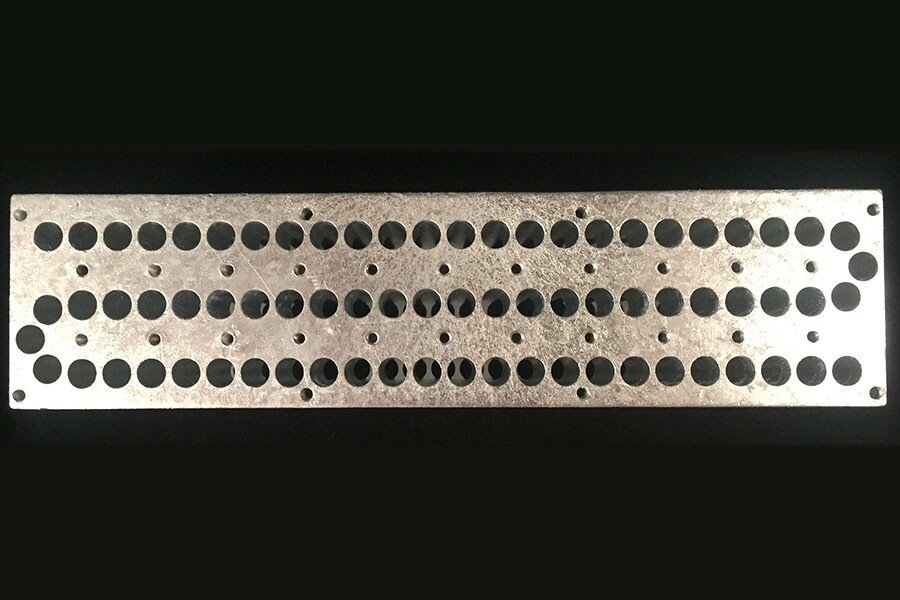博文
科学家发明了“量子长笛”,可以让光子一起运动
 精选
精选
||
科学家发明了“量子长笛”,可以让光子一起运动
诸平
据美国芝加哥大学(University of Chicago)2022年7月6日提供的消息,科学家发明了“量子长笛”,可以让光的粒子一起运动(Scientists invent 'quantum flute' that can make particles of light move together)。芝加哥大学物理学家的一项新的量子长笛实验可能为新的量子技术指明方向。这些孔产生不同的波长,类似于长笛上的“音符”,可以用来编码量子信息(详见上图所示)。
芝加哥大学的物理学家发明的这种“量子长笛(quantum flute)”,就像魔笛手一样,它可以强迫光粒子以一种前所未有的方式一起运动。
发表在《物理评论快报》(Physical Review Letters)和《自然物理学》(Nature Physics)上的两项研究描述了这一突破,它可能为实现量子记忆(quantum memories )或在量子计算机中实现新的纠错形式指明了道路,并可以观察自然界中看不到的量子现象。详见Srivatsan Chakram, Andrew E. Oriani, Ravi K. Naik, Akash V. Dixit, Kevin He, Ankur Agrawal, Hyeokshin Kwon, David I. Schuster. Seamless High-Q Microwave Cavities for Multimode Circuit Quantum Electrodynamics. Physical Review Letters, 2021, 127(10): 107701 – Published 31 August 2021. DOI: 10.1103/PhysRevLett.127.107701. https://dx.doi.org/10.1103/PhysRevLett.127.107701
Srivatsan Chakram, Kevin He, Akash V. Dixit, Andrew E. Oriani, Ravi K. Naik, Nelson Leung, Hyeokshin Kwon, Wen-Long Ma, Liang Jiang, David I. Schuster. Multimode photon blockade. Nature Physics, Published: 23 June 2022, DOI: 10.1038/s41567-022-01630-y. https://doi.org/10.1038/s41567-022-01630-y
大卫·舒斯特(David Schuster)副教授的实验室致力于量子比特(quantum bits)的研究,量子比特相当于计算机比特,它利用原子和亚原子水平上粒子的奇怪特性来做一些在其他情况下不可能完成的事情。在这个实验中,他们研究的是微波光谱中被称为光子(photons)的光粒子。
他们设计的系统由一块金属制成的长腔组成,用来捕获微波频率的光子。这种腔体是通过钻偏置孔(offset holes)制成的,就像长笛上的孔一样。
大卫·舒斯特说:“就像在乐器( musical instrument)中一样,你可以在整个乐器中发送一个或几个波长的光子,每个波长创建一个‘音符’('note'),可以用来编码量子信息(encode quantum information)。”然后,研究人员可以使用一个主量子比特,即超导电路,来控制“音符”的相互作用。
但他们最奇怪的发现是光子的行为方式。在自然界中,光子几乎从不相互作用——它们只是相互穿过。经过艰苦的准备,科学家有时可以促使两个光子对彼此的存在做出反应。
大卫·舒斯特说:“在这里,我们做了一些更奇怪的事情。一开始,光子完全不相互作用,但当系统中的总能量( total energy)达到临界点时,突然之间,它们都在相互交谈。”
在实验室实验中,有这么多光子相互“交谈”是极其奇怪的,就像看到一只猫用后腿走路一样。
大卫·舒斯特说:“通常情况下,大多数粒子的相互作用是两个粒子一对一地相互弹跳或吸引。如果你添加第三个粒子,它们通常仍然会与其中一个粒子进行顺序互动。但这个系统让它们同时相互作用。”
他们的实验一次只测试了5个“音符”,但科学家们最终可以想象通过一个量子比特来控制数百或数千个“音符”。对于像量子计算机这样复杂的操作,工程师们想要在任何地方尽可能地简化,大卫·舒斯特说:“如果你想建造一个有1000比特的量子计算机,并且你可以通过一个比特控制所有的量子计算机,这将是非常有价值的。”
研究人员也对这种行为本身感到兴奋。没有人在自然界中观察到任何类似的相互作用,所以研究人员也希望这一发现可以用于模拟地球上看不到的复杂物理现象,甚至可能包括一些黑洞的物理现象。
除此之外,这些实验很有趣。
“通常情况下,量子相互作用发生的长度和时间尺度太小或太快,我们无法看到。在我们的系统中,我们可以在任何音符中测量单个光子(single photons),并观察相互作用发生时的影响。用眼睛‘看到’量子相互作用真的非常棒,”芝加哥大学博士后研究员斯里瓦桑·查克拉姆(Srivatsan Chakram)说,他是上述2篇论文的共同第一作者,现在是美国罗格斯大学(Rutgers University)的助理教授。
上述介绍,仅供参考。欲了解更多信息,敬请注意浏览原文或者相关报道。
Twin photons from different quantum dots
Abstract (DOI: 10.1103/PhysRevLett.127.107701)
Multimode cavity quantum electrodynamics—where a two-level system interacts simultaneously with many cavity modes—provides a versatile framework for quantum information processing and quantum optics. Because of the combination of long coherence times and large interaction strengths, one of the leading experimental platforms for cavity QED involves coupling a superconducting circuit to a 3D microwave cavity. In this work, we realize a 3D multimode circuit QED system with single photon lifetimes of 2 ms across 9 modes of a novel seamless cavity. We demonstrate a variety of protocols for universal single-mode quantum control applicable across all cavity modes, using only a single drive line. We achieve this by developing a straightforward flute method for creating monolithic superconducting microwave cavities that reduces loss while simultaneously allowing control of the mode spectrum and mode-qubit interaction. We highlight the flexibility and ease of implementation of this technique by using it to fabricate a variety of 3D cavity geometries, providing a template for engineering multimode quantum systems with exceptionally low dissipation. This work is an important step towards realizing hardware efficient random access quantum memories and processors, and for exploring quantum many-body physics with photons.
Abstract (DOI: 10.1038/s41567-022-01630-y)
Interactions are essential for the creation of correlated quantum many-body states. Although two-body interactions underlie most natural phenomena, three- and four-body interactions are important for the physics of nuclei1, exotic few-body states in ultracold quantum gases2, the fractional quantum Hall effect3, quantum error correction4 and holography5,6. Recently, a number of artificial quantum systems have emerged as simulators for many-body physics, featuring the ability to engineer strong interactions. However, the interactions in these systems have largely been limited to the two-body paradigm and require building up multibody interactions by combining two-body forces. Here we implement a scheme to create a higher-order interaction between photons stored in multiple electromagnetic modes of a microwave cavity. The system is dressed such that there is collectively no interaction until a target total photon number is reached across multiple distinct modes, at which point the photons interact strongly. In our demonstration, we create interactions involving up to three bodies and across up to five modes. We harness the interaction to prepare single-mode Fock states and multimode W states, which we verify by introducing a multimode Wigner tomography method.
https://m.sciencenet.cn/blog-212210-1346827.html
上一篇:在扭曲的三层石墨烯中观察到异常的超导性
下一篇:化学家让-马利·塔拉斯孔荣获2022 CNRS 金奖
